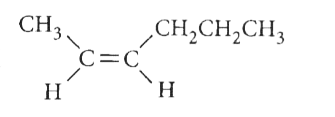Identify X in the following sequence of reactions
CH3−C∣BrH−−∣BrCH2−CH2−CH31.NaNH2−−−−−−−−−−→2.Na in liquidNH3X
CH3−C∣BrH−C∣NH2H−CH2CH2CH3


CH3−C∣NH2H−C∣NH2H−CH2CH2CH3
The correct Answer is:B
To solve the problem, we need to analyze the given sequence of reactions step by step.
Step 1: Understanding the Starting Material
The starting material is:
CH3−Br(1-bromopropane)
CH−Br(2-bromopropane)
CH2−CH2−CH3(propane)
This can be represented as:
CH3−Br−CH−Br−CH2−CH2−CH3
Step 2: Reaction with NaNH₂
When we treat the compound with sodium amide (NaNH₂), it acts as a strong base and will facilitate an elimination reaction (E2 mechanism). In this case, two moles of HBr will be eliminated from the molecule.
Step 3: Elimination Reaction
The elimination of HBr will lead to the formation of a triple bond (alkyne). The reaction can be summarized as follows:
- The bromine atoms are removed, and hydrogen atoms are also removed from adjacent carbon atoms.
- This results in the formation of a terminal alkyne.
The product after this step will be:
CH3−C≡C−CH2−CH2−CH3
This is 1-heptyne.
Step 4: Reduction with Sodium in Liquid Ammonia
The next step involves treating the alkyne with sodium in liquid ammonia. This process is known as Birch reduction, which converts alkynes to trans-alkenes.
Step 5: Formation of the Final Product
The Birch reduction will lead to the formation of a trans-alkene. The product will be:
CH3−C=C−CH2−CH2−CH3
This compound is 1-heptyne, which will be a trans-alkene.
Final Answer
Thus, the compound X that results from the sequence of reactions is:
CH3−C=C−CH2−CH2−CH3
The starting material is:
CH3−Br(1-bromopropane)
CH−Br(2-bromopropane)
CH2−CH2−CH3(propane)
CH3−Br−CH−Br−CH2−CH2−CH3
When we treat the compound with sodium amide (NaNH₂), it acts as a strong base and will facilitate an elimination reaction (E2 mechanism). In this case, two moles of HBr will be eliminated from the molecule.
The elimination of HBr will lead to the formation of a triple bond (alkyne). The reaction can be summarized as follows:
- The bromine atoms are removed, and hydrogen atoms are also removed from adjacent carbon atoms.
- This results in the formation of a terminal alkyne.
CH3−C≡C−CH2−CH2−CH3
This is 1-heptyne.
The next step involves treating the alkyne with sodium in liquid ammonia. This process is known as Birch reduction, which converts alkynes to trans-alkenes.
The Birch reduction will lead to the formation of a trans-alkene. The product will be:
CH3−C=C−CH2−CH2−CH3
This compound is 1-heptyne, which will be a trans-alkene.
Thus, the compound X that results from the sequence of reactions is:
CH3−C=C−CH2−CH2−CH3
Topper's Solved these Questions
- BOOK - ERRORLESSCHAPTER - HYDROCARBONSEXERCISE - NCERT BASED QUESTION (AROMATIC HYDROCARBON)78videos
HYDROCARBONS
- BOOK - ERRORLESSCHAPTER - HYDROCARBONSEXERCISE - PAST YEAR QUESTIONS88videos
HYDROCARBONS
- BOOK - ERRORLESSCHAPTER - HYDROCARBONSEXERCISE - NCERT BASED QUESTION (ALKENE)76videos
HYDROCARBONS
- BOOK - ERRORLESSCHAPTER - GENERAL ORGANIC CHEMISTRY EXERCISE - ASSERTION AND REASON14videos
GENERAL ORGANIC CHEMISTRY
- BOOK - ERRORLESSCHAPTER - HYDROGENEXERCISE - ASSERTION & REASON6videos
HYDROGEN
Similar Questions
Knowledge Check
- Question 1 - Select One
Identify X in the following sequence of reactions :
CH3−C|BrH−C|BrH−CH2−CH2−CH31.NaNH2−−−−−−−−−−−→ 2. Na in liquidNH3XACH3−CH| Br −CH| NH2−CH2CH2CH3B C
C DCH3−CH| NH2−CH| NH2−CH2CH2CH3
DCH3−CH| NH2−CH| NH2−CH2CH2CH3 - Question 2 - Select One
Identify X in the following sequence of reactions :
CH3−C∣BrH−C∣BrH−CH2−CH2−CH31.NaNH2−−−−−−−−→2.Na in liq.NH3XACH3−C∣BrH−C∣NH2H−CH2CH2CH3B C
C DCH3−C∣NH2H−C∣NH2H−CH2−CH2CH3
DCH3−C∣NH2H−C∣NH2H−CH2−CH2CH3 - Question 3 - Select One
The major product of the following reaction is:
CH3C∣BrHCH2C∣BrHCH2CH3KOH,CH3OH−−−−−−−−→heatACH2=CHCH2CH=CHCH3BCH2=CHCH=CHCH2CH3CCH3CH=C=CHCH2CH3DCH3CH=CH−CH=CHCH3
CH3C∣BrH−CH3∣C∣OH−C−O−CH3
View SolutionThe major product of the following reaction is :
CH3CH2C∣BrH−C∣BrH2I.KOHalc.−−−−−−−−−−−−→II.NaNH2in liq.NH3View SolutionGive IUPAC name of :
CH3−CH2−CH∣Br−−CH3∣C∣Br−CH2CIView SolutionThe major product of the following reaction is :
CH3CH2CH∣Br−C∣BrH2(i)KOHalc.−−−−−−−→(ii)NaNH2 in liqNH3View SolutionThe IUPAC name for the compound
CH3−C∣OHH−CH2−C∣BrH−CHO, isView Solution

